Overview

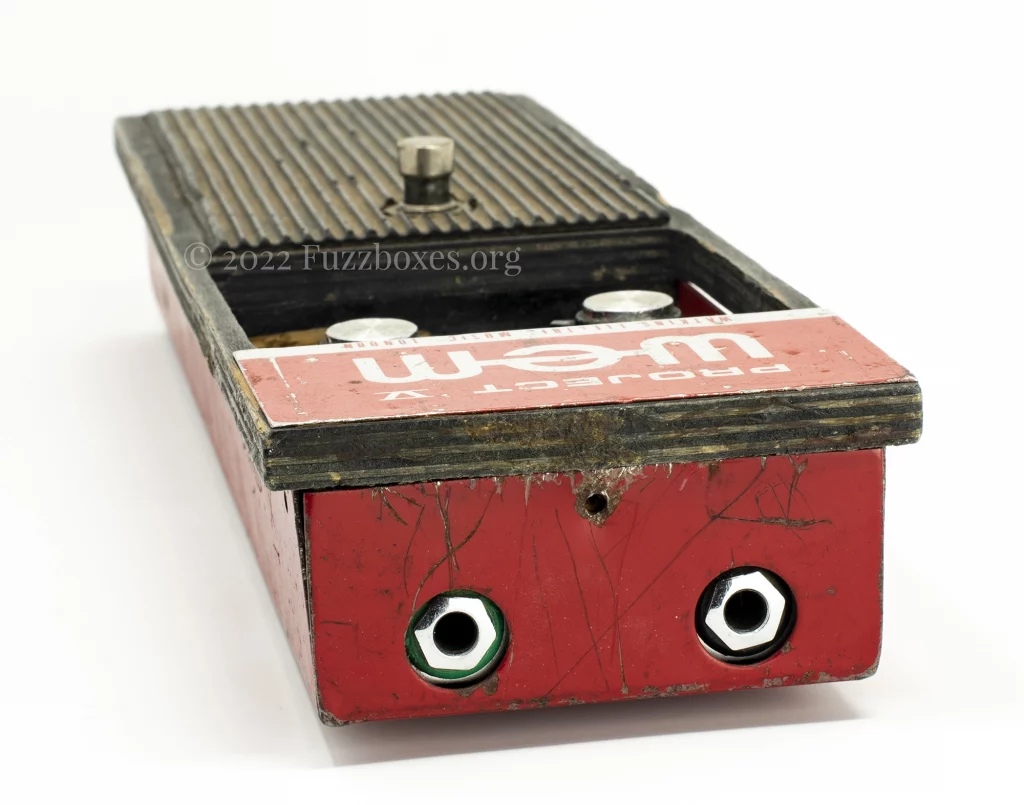
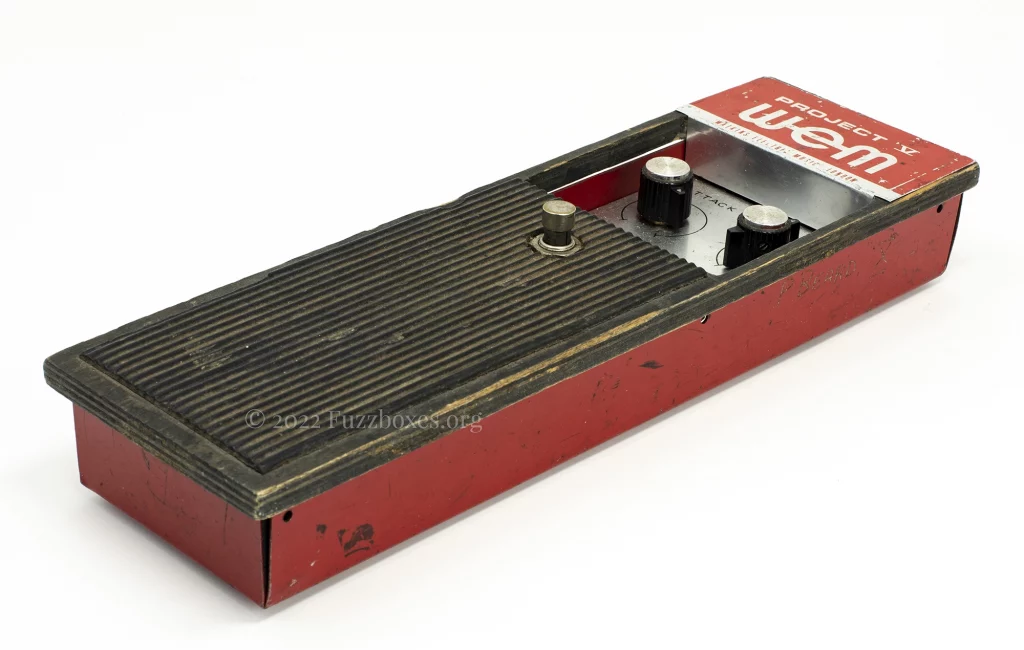
WEM was one of the first major companies in the UK to offer commercial fuzz boxes, and based on the number of surviving examples (and despite being a relatively crude-sounding two-transistor design) the WEM Rush Pep Box seems to have sold reasonably well between 1965 and 1967. By the late 1960s, however, WEM went on to offer a far more sophisticated fuzz box, in the form of the Project V.
The origins of the Project V may be found (at least conceptually) in the WEM ‘Fifth man’ guitar. The ‘Fifth man’ was advertised in a 1967 Bell catalogue, and it featured similar controls for the ‘drive’ and ‘edge’ of its Project IV effect. Whether the electronic circuit of the Project V fuzz box is similar to that in the ‘Fifth man’s’ Project IV feature is unknown.
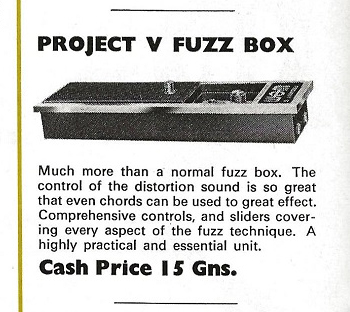
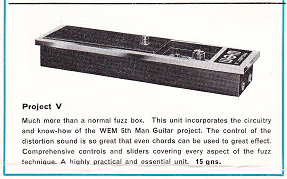
Early examples of the Project V date to 1968, but date codes on parts inside pedals alone aren’t sufficient for ascertaining when production began, because the Project V was not advertised until the following year. Most surviving examples feature potentiometers dating to 1969. Pictured above are a pair of early advertisements for the WEM Project V printed in 1969.
Tech specs
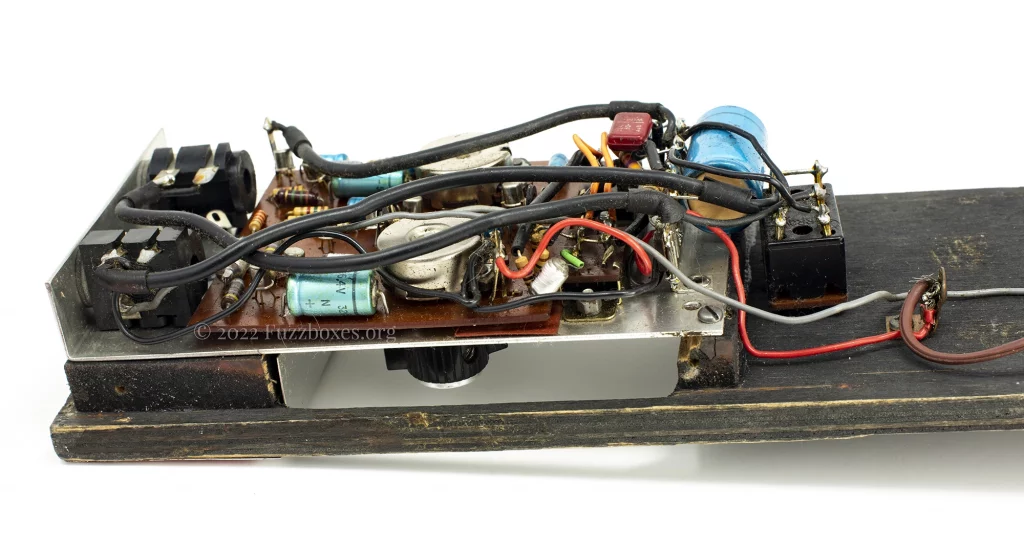
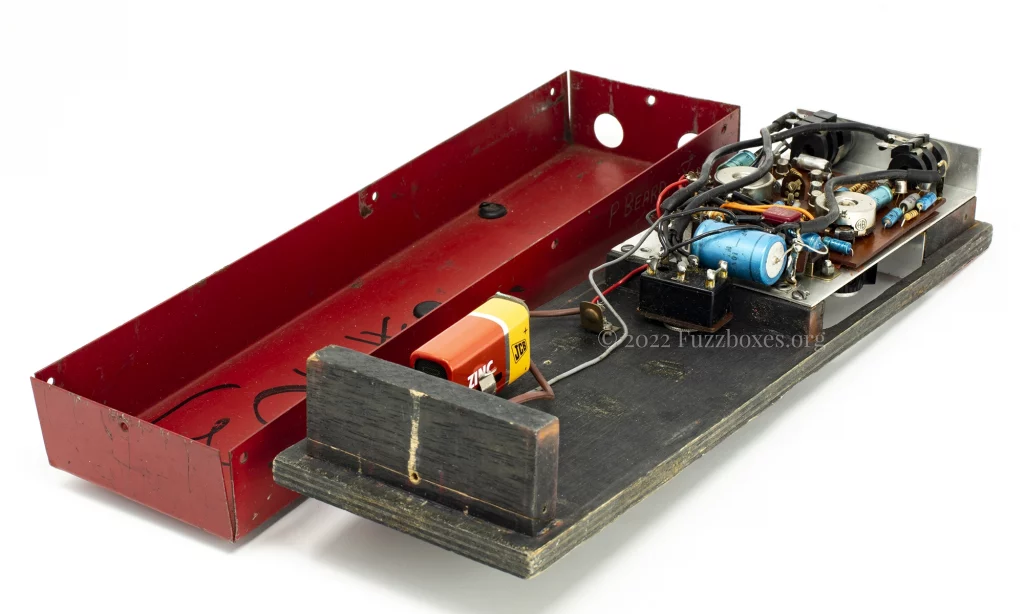
The circuitry of the WEM Project V was built onto an aluminium bracket, and this was then screwed onto a larger wooden surface where the footswitch and battery contacts were mounted. A rectangular frame made out of folded aluminium was fitted across the face of the pedal, which covered the exposed wooden sides. The red removable bottom cover was made out of folded steel.
In addition to the typical controls of a fuzz box (for the output volume of the pedal, as well as the amount of fuzz produced) the Project V featured ‘drive’ and ‘edge’ toggle switches for brighter and darker flavours of the fuzz effect . The Project V also included two internal trim pots for further adjustment.
The Project V’s circuit featured 8 silicon transistors and an inductor, and was far more sophisticated in its design than most fuzz boxes from the 1960s. Part of the schematic is based off a textbook quasi-complementary amplifier.
Individual battery contacts and a pair of slim Terry clips were screwed into the underside of the wooden frame of the pedal. According to the testimonies from two original owners of Project V pedals, these units were powered by a single cylindrical 8.4 volt battery (offered at the time by Mallory and also by Eveready). A suitable modern substitution is the Excell A136 battery, but connectors for modern 9 volt batteries can also safely be fitted to Project V battery contacts.
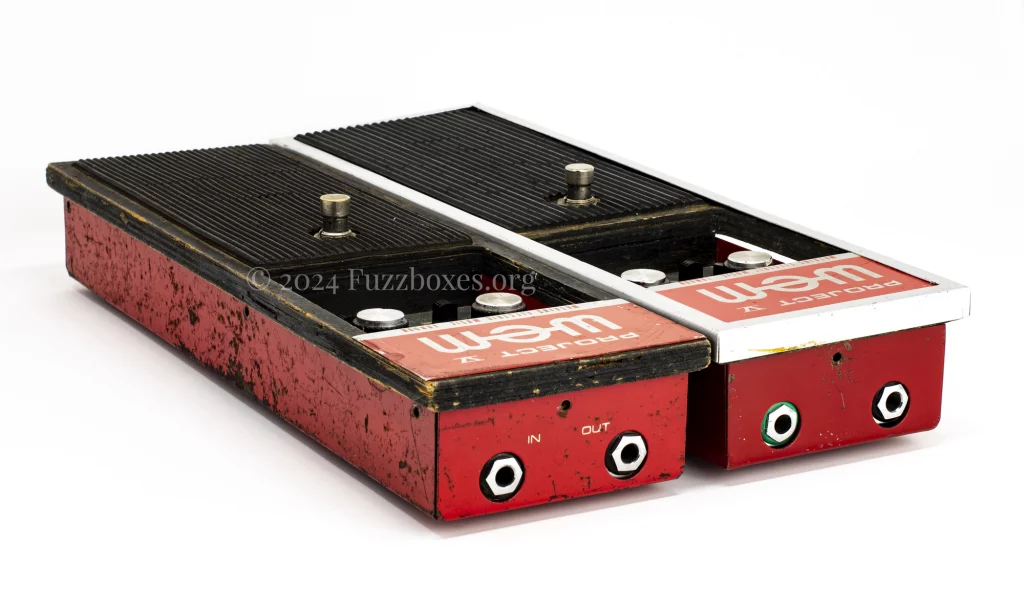
Earlier Project V pedals (pictured above-left) came with printed ‘in’ and ‘out’ labels for the jack sockets, while later ones were fitted with green washers to tell them apart.
Different versions
Many Project V fuzz boxes were crudely numbered with felt-tip pen on the inside of the bottom plate. These numbers correlate with changes in construction and parts selection, and this enables us to arrange surviving Project V’s into a chronological sequence. It is unknown how many Project V pedals were produced in total, but a selection of the different versions is pictured in this section.
PW0046


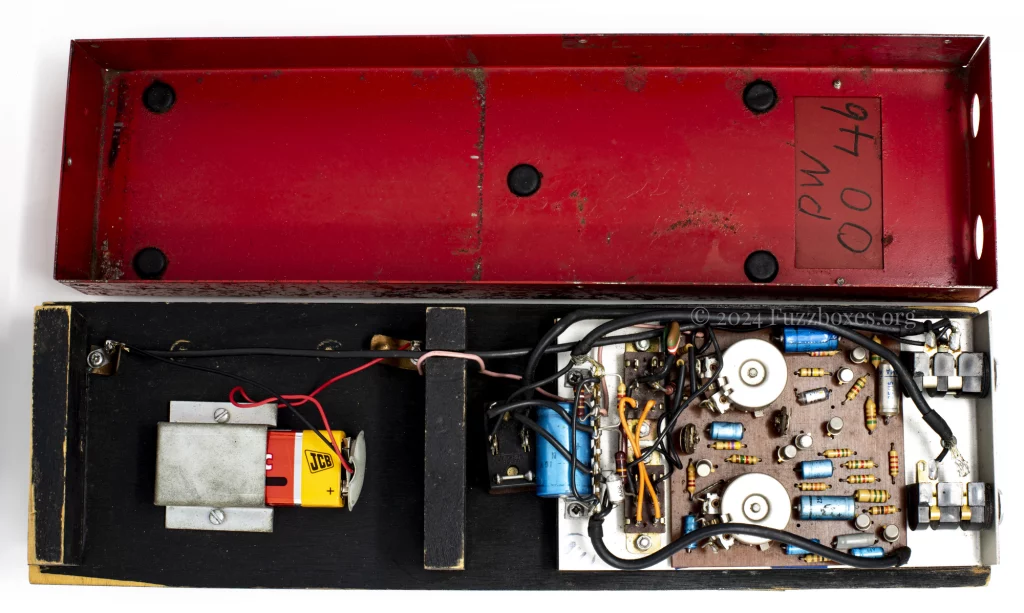
This pedal is likely the earliest known surviving Project V thus far. The red bottom cover has a removable battery hatch close to the jack sockets (upon which the serial number has been written). This was a remnant of the discontinued WEM Rush Pep Box pedals, which were powered by conventional 9 volt (PP3) batteries that sat behind that removable hatch. The Project V had a very different internal layout to the Pep Box, and there was obviously no room for a battery behind the jack sockets. Later Project V pedals omitted that removable battery hatch.
Another distinctly ‘early’ feature, as seen on this pedal, is the use of circular control knobs. These knobs were eventually phased out on the Project V (along with other WEM products in the late 60s) in place of knobs with a protruding pointer.
These early Project V’s had an additional wooden block positioned between the battery contacts and the footswitch & circuitry. A small channel was cut out of the block through which the power wires travelled. WEM appeared to have phased out the use of that additional block particularly early on during production, as it is a very rare feature to see.
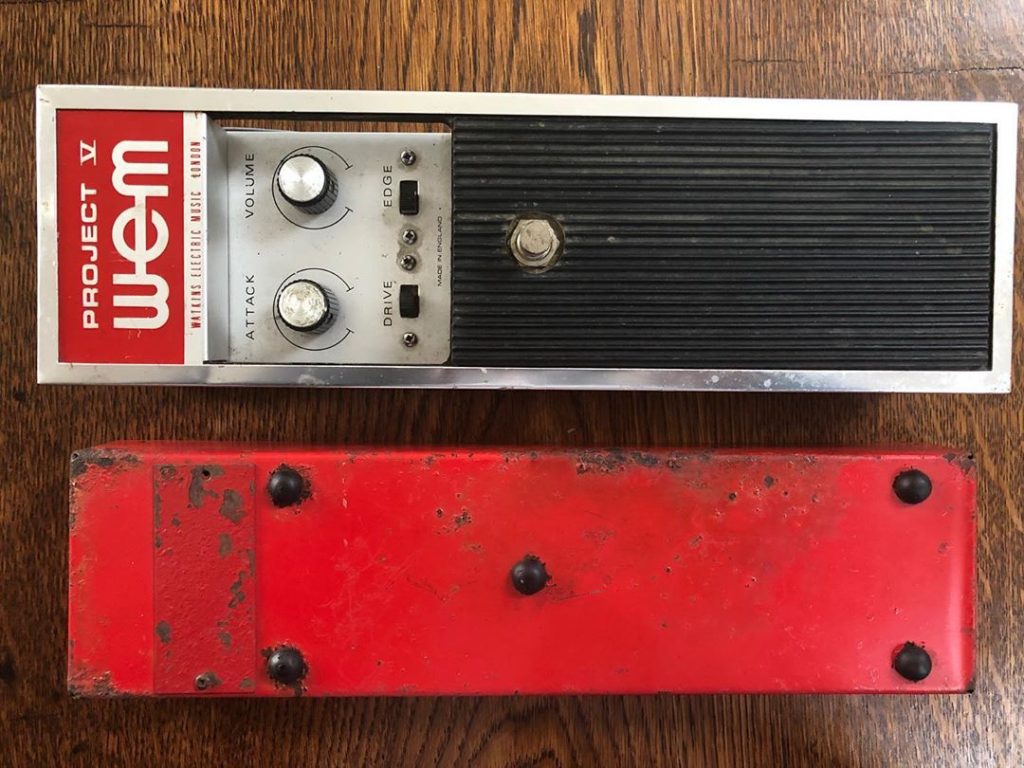
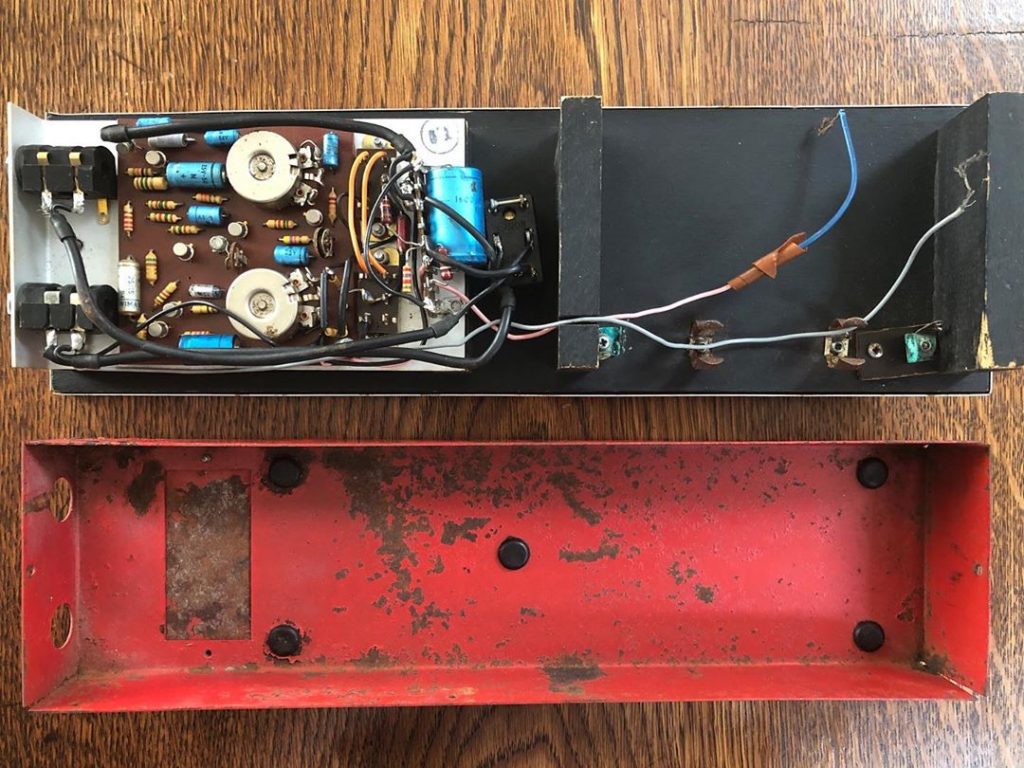
The Project V pictured above is also a very early example, with all of the same features as #46 pictured previously. Unfortunately this pedal has lost its serial number over time, but it’s likely to have been built fractionally later, due to the presence of the same polystyrene film capacitor connecting the signal from the volume pot to the edge switch. Project V #46 uses a tropical fish capacitor in that position, which hasn’t yet been sighted in any other exemplar. (Photo credit: R. Dingli)
The potentiometer date codes in both pedals are ‘B8’ (February 1968).
78
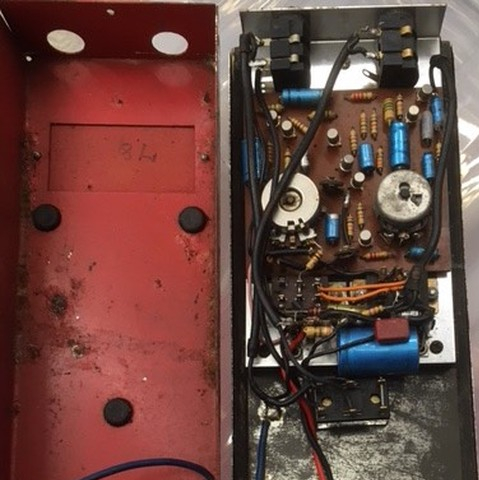
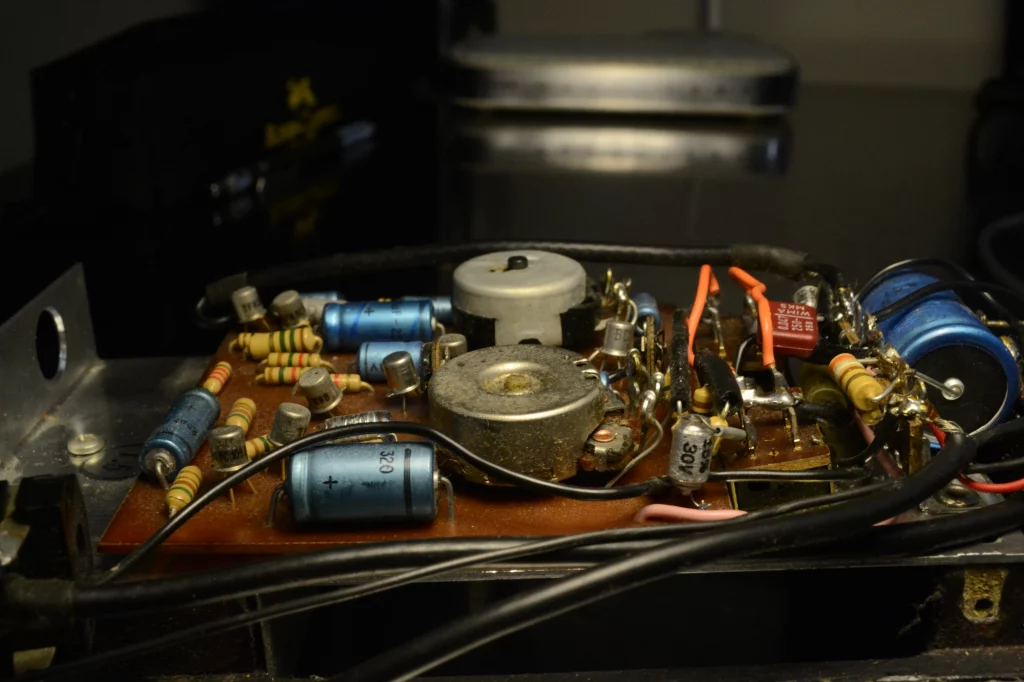
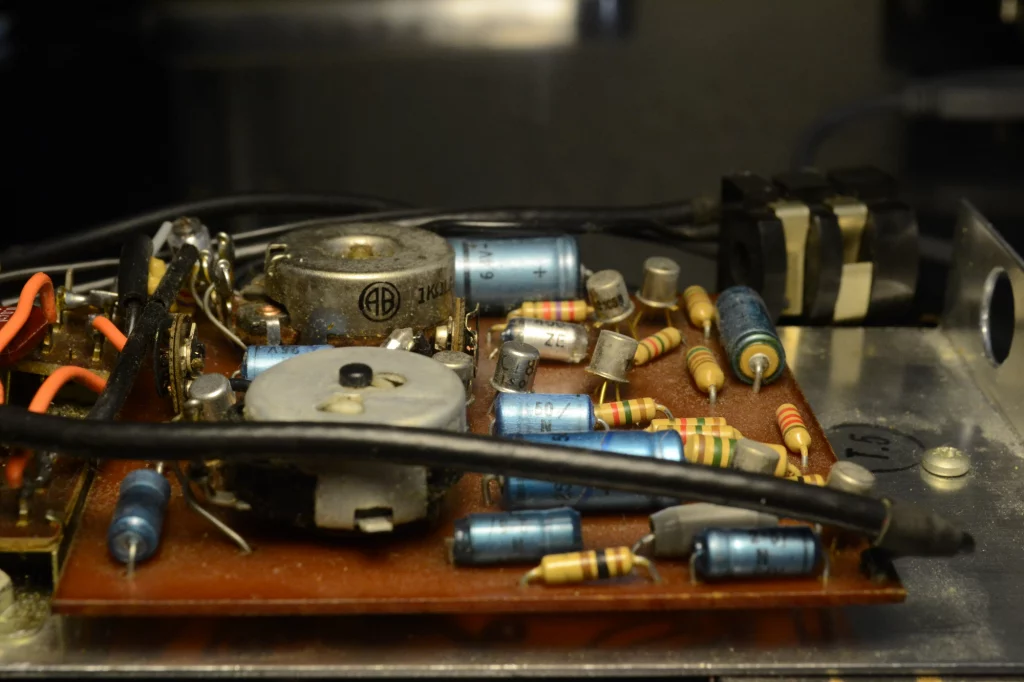
The gallery of photos here is actually of two separate (but identical) pedals. Both pedals have early features, such as the obsolete battery hatch and the circular control knobs. They have the same ‘B8’ stamped Allen-Bradley volume potentiometer, but for some reason WEM fitted a Morganite pot for the attack control instead. The Morganite pot is dated the 36th week of 1968. (Photo credits: Vintage & Rare, C. Clements)
By the time that these two pedals were built, WEM had stopped fitting the divider block of wood between battery & circuitry. The schematic was also modified very slightly to include a small pull-down polystyrene capacitor, which was crudely connected between the trim pots on the parts-side of the PCB.
The first pedal above bears the serial number 78. The second pedal’s number is sadly unknown.
#103
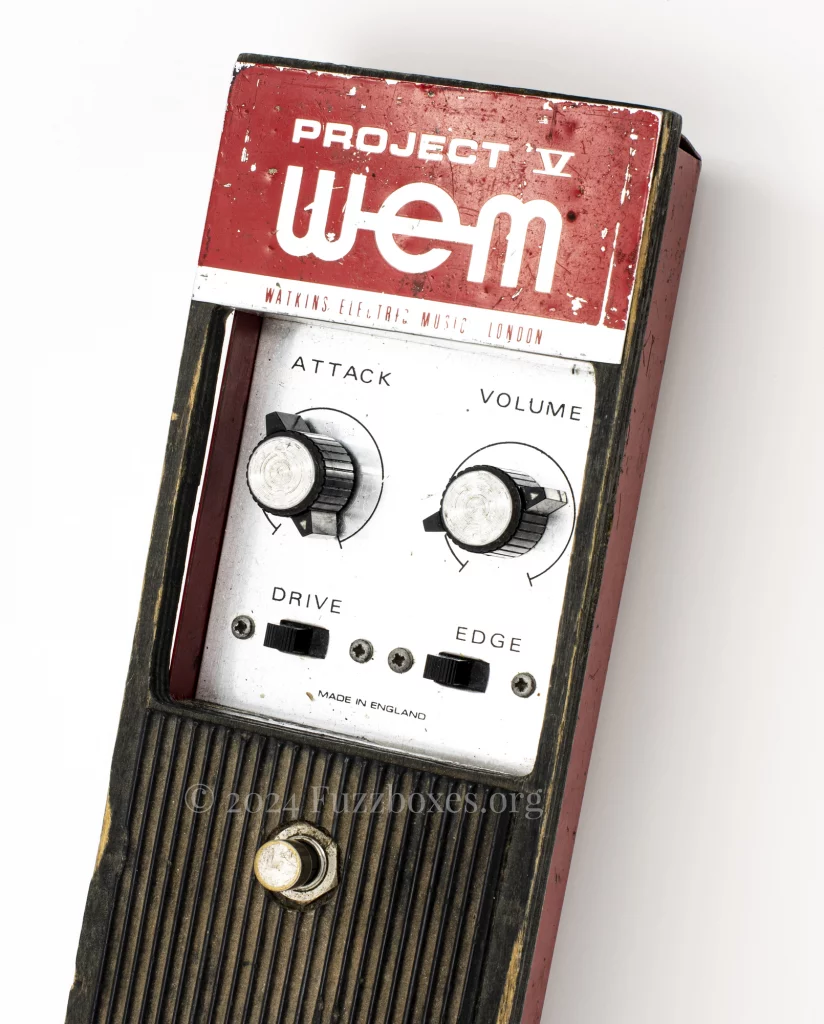
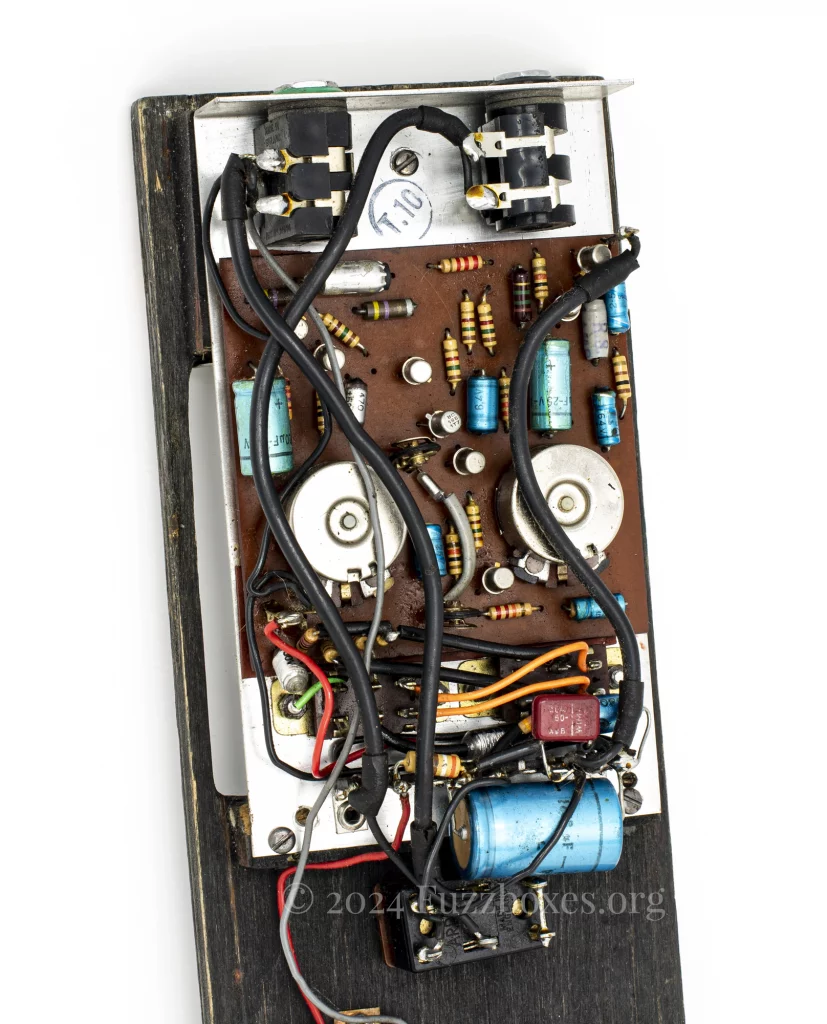
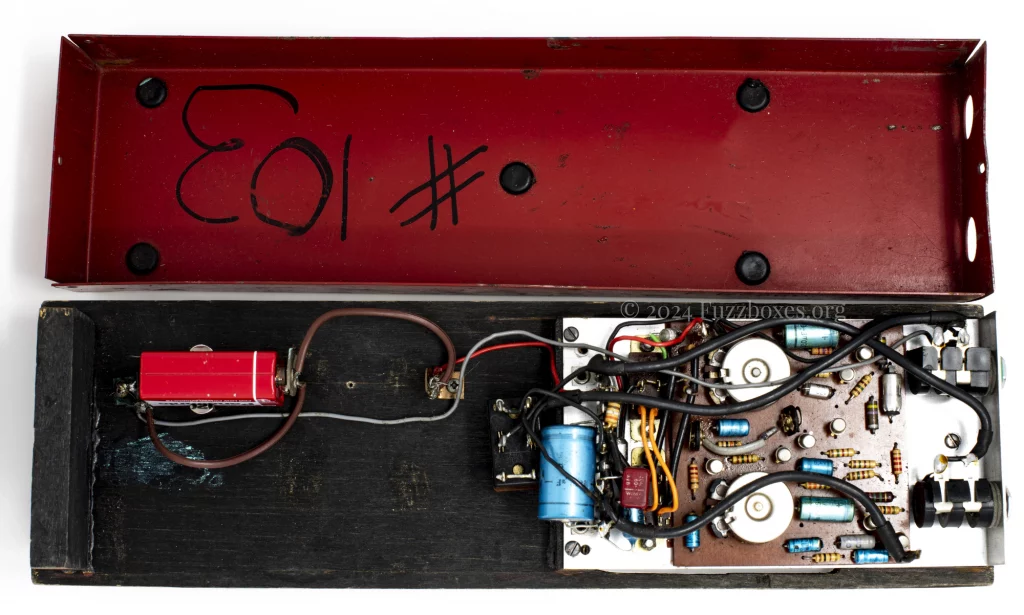
Project V #103 marks a number of design changes in the sequence. The circular knobs fitted to earlier Project V’s were updated to a new style with protruding pointers, and these would have been a lot easier to see and set in low-light environments.
By the time that this pedal was built, WEM had also updated the red bottom plates to omit the unused Pep Box-era battery hatch. Potentiometer date codes on #103 are ‘C9’ (March 1969).
#103 is also the earliest Project V pedal to have been seen with the green washer denoting the input jack socket, instead of printed ‘in’ and ‘out’ labels.
128
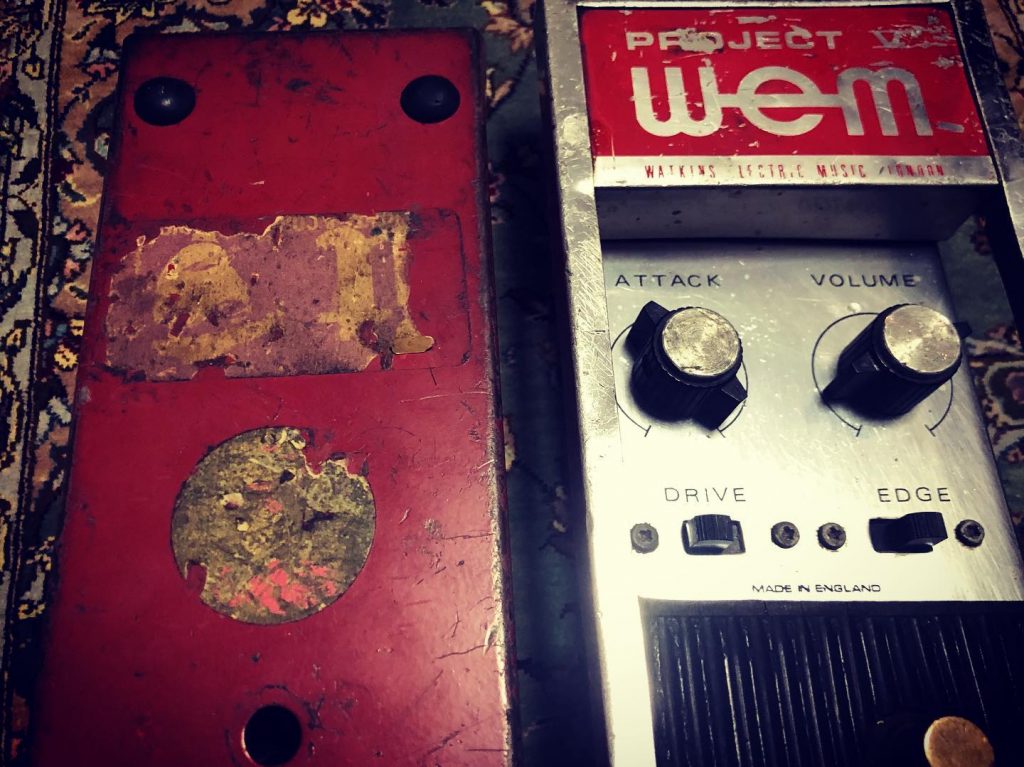
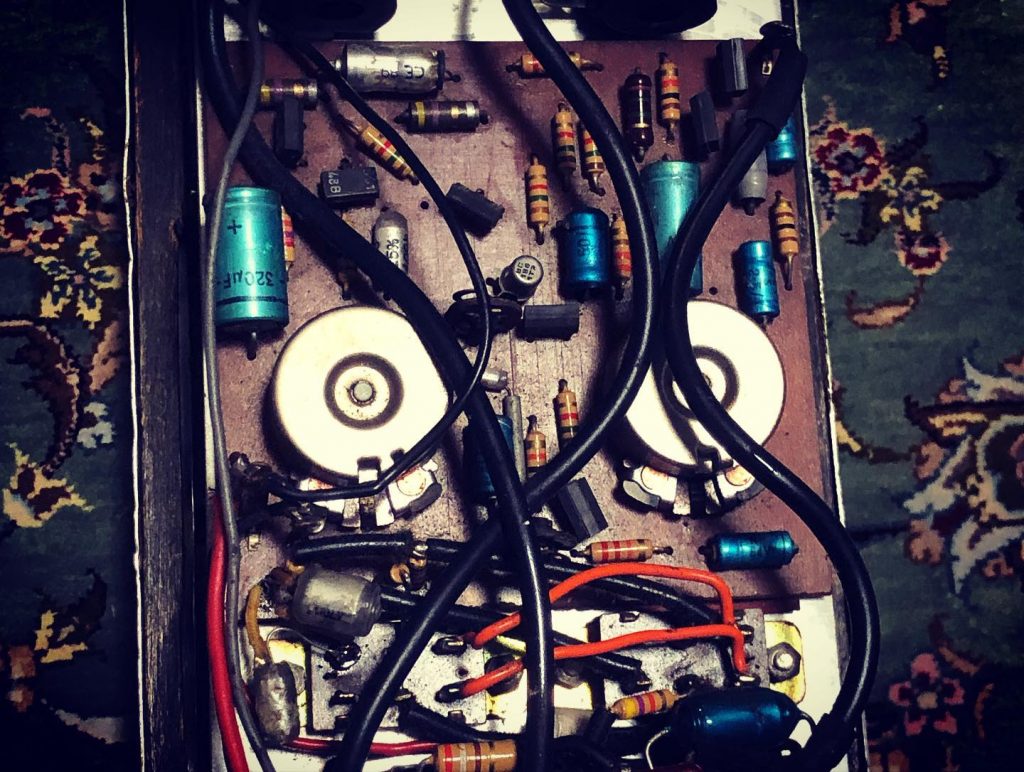
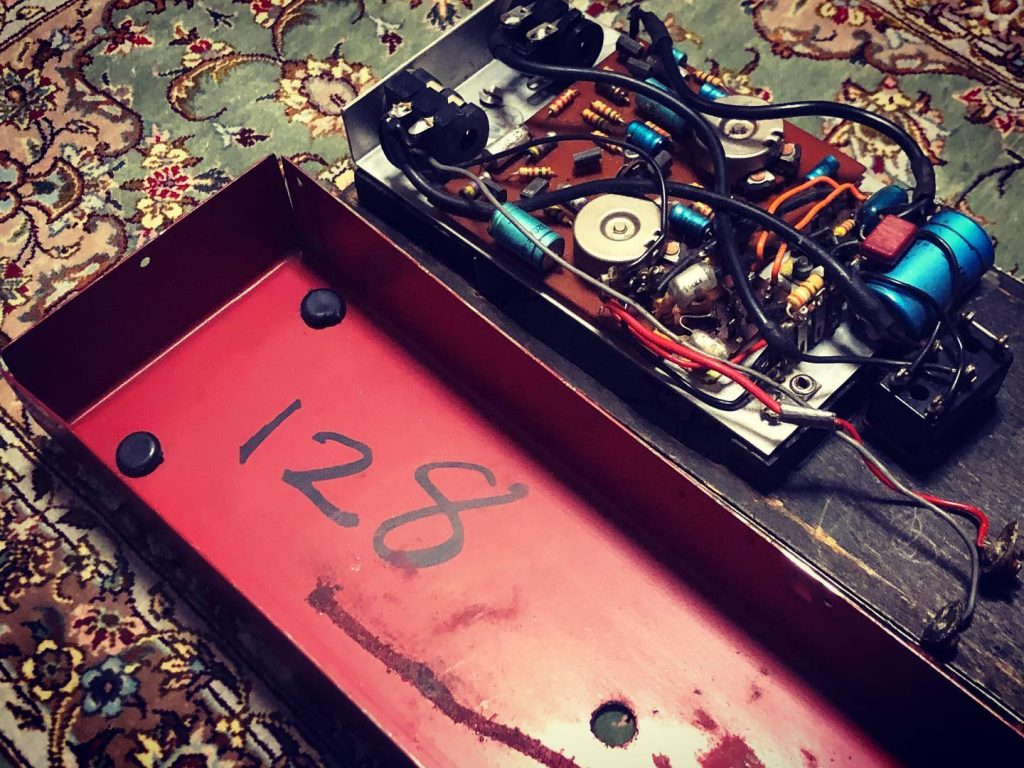
At the time of writing, #128 is a unique Project V. Unsurprisingly, it is almost identical to #103 (pictured previously) — the same mixture of resistors and the same ‘C9’ potentiometer date codes. This pedal has one critical difference, however, and it is that the circuit board has been assembled using BC149B transistors in place of the BC108B transistors used for both earlier and later Project V’s. It isn’t known at this point whether the original transistors in this pedal were replaced at one point, or whether these BC149B’s may have been very briefly used at the factory. (Photo credit: Y. Asai)
983
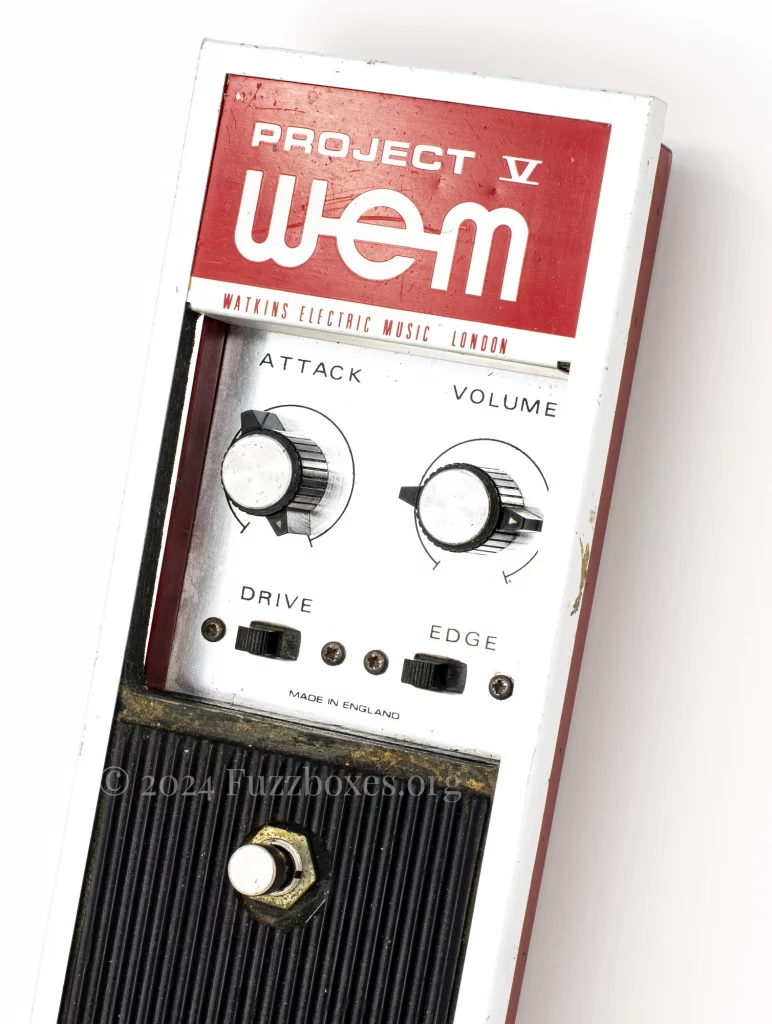
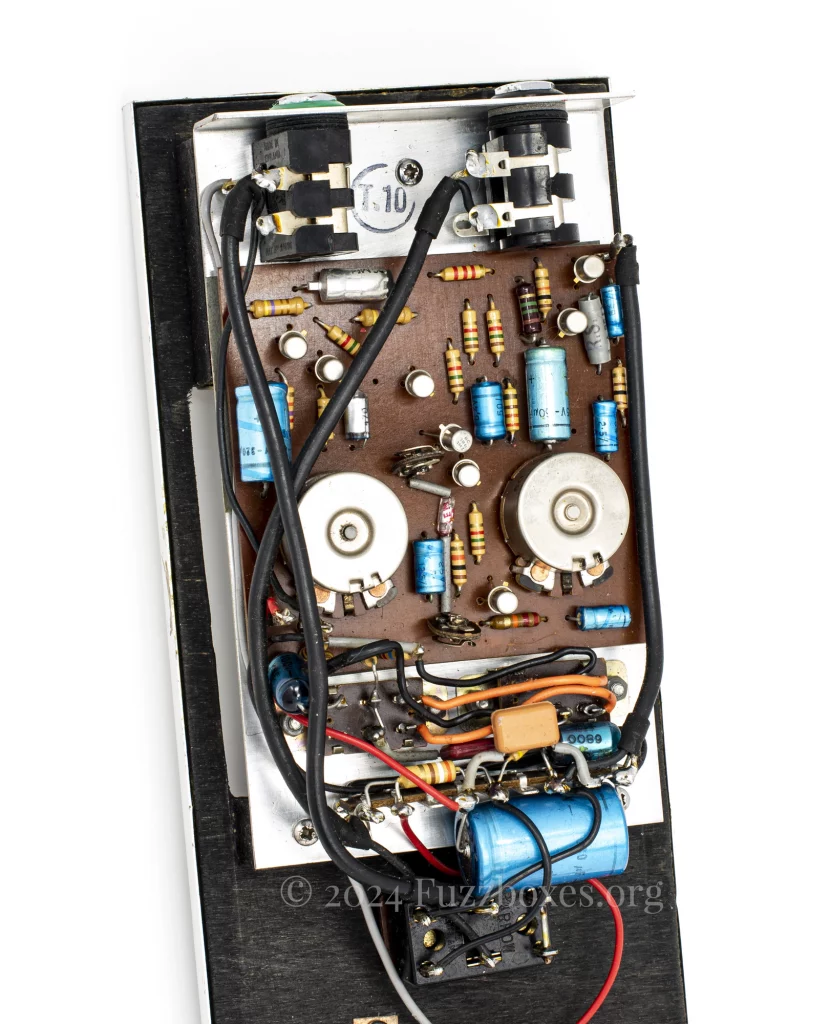

There is a big jump in the sequence of numbered Project V pedals from the 100s to the 900s. A cluster of Project V’s with serial numbers in the 900s have resurfaced over the years, and they all have identical components to the exemplar pictured here. Given how rare the WEM Project V pedals are, it is very difficult to imagine that WEM could have built anywhere close to the region of a thousand units, and we may need to wait for more information or pedals to surface in order to get a better understanding of WEM’s numbering system.
Project V’s with these later serial numbers also have the latest known potentiometer date codes: D9 and J9 (April & October 1969, respectively).
Eno’s fuzz
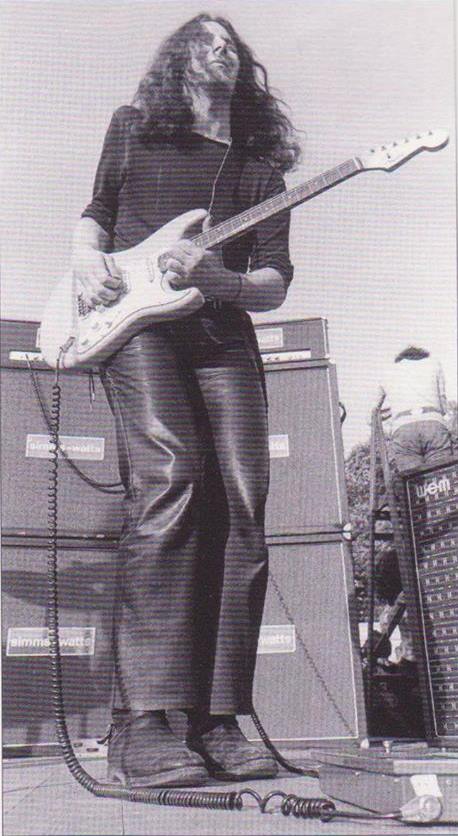
Two well-known users of the Project V include Paul Rudolph, of Deviants & Pink Fairies fame, as well as Brian Eno. Rudolph confirmed via private correspondence that it was in fact his WEM Project V that was either loaned to Eno, or left behind at the studio, following the Here come the warm jets sessions.1
Pictured is Paul Rudolph, performing with the Deviants at the Hyde Park Free Concert on September 20th, 1969, with a WEM Project V at his feet. This is the exact pedal that Brian Eno would go on to describe using for some of his guitar treatments during the 1970s.2 (Photo credit unknown)
Share your fuzz!
I welcome any comments, feedback, queries & corrections in relation to the Fuzzboxes.org project. Please get in touch via this contact form (or on the ‘contact‘ page).
Much of our understanding of the development of 1960s fuzz boxes comes from analysis of surviving pedals themselves, and so photos of pedals belonging to readers are particularly useful in furthering this research.
If you would like to contribute pictures of 1960s-era guitar effects to Fuzzboxes.org, then feel free to send in any pictures via the uploader below. Photos are greatly appreciated, and any submissions are not published on this website without advance agreement with the contributor.
Thanks to the P. Beard, S. Castledine, M. Keeble, H. Barclay, the WEM Owners Club [https://www.wem-owners.com] & Paul Rudolph

I have built a replica from a counter balance tool box tray